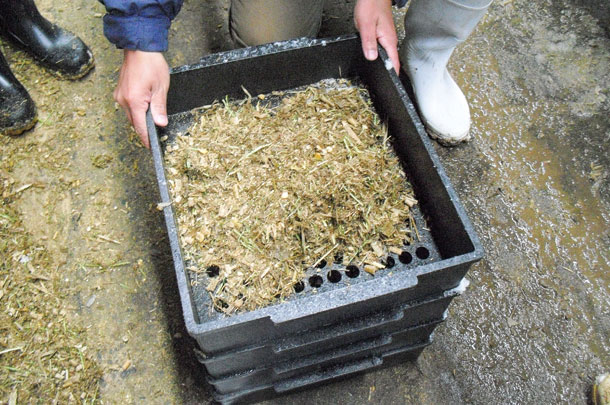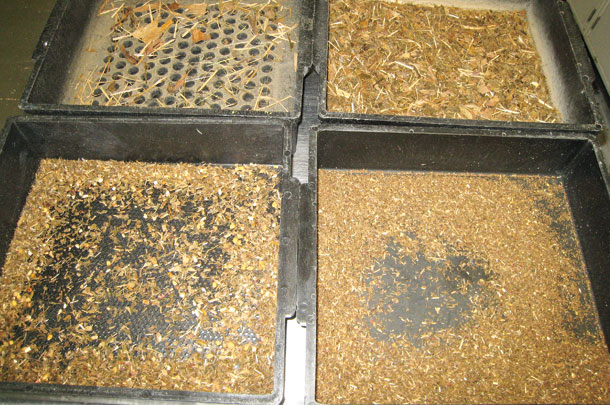How important is it to feed rations formulated with an accurate physically effective fiber (peNDF) value? Can we formulate and feed rations using “book” library values for peNDF?
Turns out that feeding rations with the wrong amount of peNDF can have a big cost. When the physical effectiveness factor (PEF) was actually measured and used in ration formulation instead of tabular book values, it was reported that the difference in expected milk from metabolizable protein could be a whopping 5.5 to 6.6 pounds.
In addition, an appropriate amount of peNDF helps avoid costs associated with subclinical ruminal acidosis (SARA). These consequences mean that knowing the actual peNDF of a ration is economically very important.
Adequate peNDF in rations of lactating dairy cows is essential to maintain rumen pH in a range that optimizes diet digestibility and animal productivity and health. Inadequate ration peNDF reduces ruminal pH and is associated with milkfat depression and with serious health disorders such as SARA, laminitis, hemorrhagic bowel syndrome, toxic indigestion, off-feed incidents and displaced abomasum.
Originally, effective NDF (eNDF) was defined as fiber necessary to maintain butterfat. Later, eNDF was redefined as peNDF and characterized as fiber that stimulated chewing.
It was also demonstrated that peNDF (percent of DM) is strongly linked to rumen pH. Inadequate ration peNDF reduces feed digestibility because at low rumen pH, rumen microbes are less efficient at digesting fiber. Insufficient peNDF also decreases diet digestibility and feed efficiency because feed passes through the rumen faster, decreasing rumen retention time.
On the other hand, too much ration peNDF (in excess of the peNDF needed to maintain a healthy rumen pH) may also reduce diet digestibility and energy density (and thus productivity) if more extensively fermentable carbohydrate sources are displaced or if intake becomes limited by gut fill.
Bottom line: Like Goldilocks and the three bears, the porridge (ration and peNDF) has to be “just right,” not too hot and not too cold.
However, accurately knowing the amount of peNDF a ration will supply is difficult. Before a ration is actually mixed and fed, it is difficult to know what the actual peNDF content will be when the ration is delivered to the feedbunk.
Sometimes this is because the PEF of the forage ingredients has not been measured prior to formulating a diet, and book values are used. When book values are used, however, work at Miner Institute reported a large variation in actual measured PEF compared to feed library book or table values of individual feeds. This indicates it is important to assess the actual peNDF of the feeds being fed and not rely on default library values.
More importantly, mixing the TMR varies tremendously between dairies, with large and variable effects on TMR peNDF as presented to the cows. This variation is related to mixer type, mixing time, knife and auger sharpness and wear, kicker plate adjustment, mix pause settings, ingredient loading order, feed dry matter, forage maturity and fragility.
Therefore, it is important to measure the PEF of a diet after it has been mixed. Afterward, it is important to calibrate the calculated PEF of a ration to the actual observed PEF, adjusting the PEF of individual feeds and, if needed, reformulating rations with more appropriate peNDF.
Furthermore, PEF is often measured by different methods that do not determine consistent PEF values. For instance, PEF factors are not valid estimates when obtained by measuring the material on the top two screens (19 mm, 8 mm) of the original three-fraction Penn State Particle Separator (PSPS) or the top three screens of the four-fraction PSPS when the third screen is the 1.18-mm screen.

However, the four-fraction PSPS using the current 4-mm third screen does estimate peNDF reasonably well. The PSPS measures feeds based on horizontal shaking which separates particles primarily by length, whereas the original concept of peNDF determination was based on vertical shaking of dry samples.
Vertical shaking separates particles mostly by diameter or width; therefore, PSPS (4 mm) results obtained by horizontal shaking are still slightly different from the vertical separation originally used to define peNDF. An alternative field method, the Z-Box developed at Miner Institute, uses manual vertical shaking.
However, the Z-Box uses different-sized screens (3.187 mm for TMR) than the 1.18 used in the derivation of the peNDF system. Nonetheless, the Z-Box also agrees reasonably well with the vertical dry sieving technique using a 1.18-mm screen.
Given the economic and health costs associated with reduced intake, reduced diet digestibility or ruminal acidosis, it is sometimes surprising to find that monitoring or troubleshooting rations has not included screening and assessing peNDF. For field use, the best recommendation is to use the four-fraction PSPS with the current 4-mm screen or, alternatively, the Z-Box with the appropriate screen.

Both are useful for assessing PEF, but an advantage of the PSPS over the Z-Box is that the proportion of material remaining on the PSPS top screen (19 mm) provides information on the sortability of a screened TMR sample, whereas the Z-Box does not provide information on sortability. Independently of total peNDF content, sortability is strongly linked with rumen pH and the susceptibility to SARA, so information on sortability is useful.
Another potential obstacle to obtaining accurate PEF values for calculating peNDF is poor screening technique. The sample size and the shaking itself in terms of number of shakes, shaking intensity and direction have a large effect on the screening result. Users should know and follow the recommendations for each screen type’s use.
For instance, on the PSPS, it is helpful to place a piece of duct tape on the edge of the long side of the top screen, which helps ensure counting the correct number of turns and shakes.
The Z-Box directions prescribe three replicates with a 50-g sample. An easy and economical alternative to screening feeds on the dairy is provided by the Cumberland Valley Analytical Services forage analysis laboratory, which has developed an automated shaker system for the PSPS, which provides repeatable results without variation arising from run-to-run shaking differences.
A further challenge is that even when a ration has been properly screened for peNDF, it is difficult for the nutritionist to reformulate a ration and be confident the reformulation will contain an improved and appropriate amount of peNDF.
Screening the TMR provides information on the peNDF of the current TMR but doesn’t provide information on the ration ingredients, especially on individual forages. Therefore, the ration reformulations often use the original PEFs and simply change the forage amount and the forage-to-concentrate ratio using a “guesstimate” of how much change is needed to improve the diet.
A better alternative, especially when large quantities of hay are included in the mix (especially alfalfa hay), is to determine the peNDF content of the TMR and then empirically adjust the PEF coefficients of individual ingredients until the observed peNDF (determined by screening the TMR) matches the one calculated from the ingredients (usually available from the ration formulation software).
The nutritionist can use observation of the mix, of the separate ingredients and prior ingredient screening to guide the empirical adjustment of the PEF for each feed until the calculated peNDF matches the observed peNDF. The user would typically adjust feeds that have the greatest apparent variance from the currently applied or tabular value.
After the adjustment is made and the estimated PEF is rendered to a value similar to the observed PEF, the revised and adjusted value for the peNDF of the ration will be a better estimate of the true ration peNDF content. Then using the revised individual feed PEF values, the ration can be reformulated and the peNDF of the reformulated ration should be more accurate.
This iterative process of formulating and mixing a dairy ration, screening and evaluating the mix peNDF and then revising the ration with more appropriate PEF values on the feeds (mostly forages) can be an important tool for troubleshooting and resolving dairy herd performance problems linked to ration peNDF content, such as butterfat depression, loose manure, toxic indigestion and other health or performance problems. PD
Buzz Burhans is with Dairy Nutrition & Health. Email Buzz Burhans.
PHOTO 1: One field method to determine peNDF is the Z-Box, which uses vertical shaking – originally used in the derivation of the peNDF system. Photo courtesy of Miner Institute.
PHOTOS 2 & 3: Another field method to determine peNDF is using the four-fraction Penn State Particle Separator, using the current 4-mm third screen. Photos courtesy of Penn State Animal Science Department.






